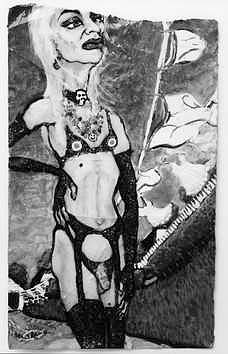The Art of Jerome Caja
Odyssey and Underworld — The Art of Jerome Caja, Charles Sexton and Thomas Plageman
Show opens Sunday, June 4
Opening Reception, Sunday, June 4; 5-7:30 pm
Location: SomArts, 934 Brannan @ 8th Street
Info: Qcc
Donation
Gallery Hours: Wednesday — Sunday, June 7 — 22; Noon — 7:30 pm
Odyssey and Underworld brings together three artists who create pictorial environments wherein rituals of survival, sexuality and communion are enacted. In Charles Sexton’s monoprints and paintings, figures huddle together around primordial fires seeking deliverance from hostile gods. Thomas Plageman’s militarized landscapes depict the body’s mobilizations against political, biological and spiritual besiegement. The media in which Jerome Caja worked, including funerary ash, lead, and refuse, express the artist’s willingness to reclaim our culture’s castoffs: what is seen as valueless, soiled, exhausted of its purpose. Jerome’s imagery, likewise, directly confronts the ongoing ravagement of nature, and satirizes cultural obliviousness to and insulation from death. Through their idiosyncratic use of symbolism, myth, anthropomorphism and religious iconography, these three artists create powerful work impelled by trials of artistic and physical endurance.
Visual art / lecture
Explosive Agendas: Somatic Landscapes
Thomas Avena & Adam Klein
Tuesday, June 20; 7:30 pm
Location: SomArts, 934 Brannan @ 8th Street
Tickets: $10, Qcc
In the art of Jerome Caja, Thomas Plageman and Charles Sexton the dynamics of disease, like nature itself, is harnessed for regenerative and creative ends. Herein lies some of the more disturbing and explosive aspects of their work: that disease can ever be harnessed for a purpose, let alone one as vital as the reclamation of the human imprint, the potency of human spirit. We will attempt to explore how “AIDS Art” in its brutal, and sometimes surprisingly mordant manifestations, aligns itself closely with the themes that have imbued great art throughout the ages. Rather than seeing this work as confined to a specific historical set of circumstances, such powerful images continue to draw a portrait of the human psyche, wherein there is no true separation between death and the possibility of creation.

